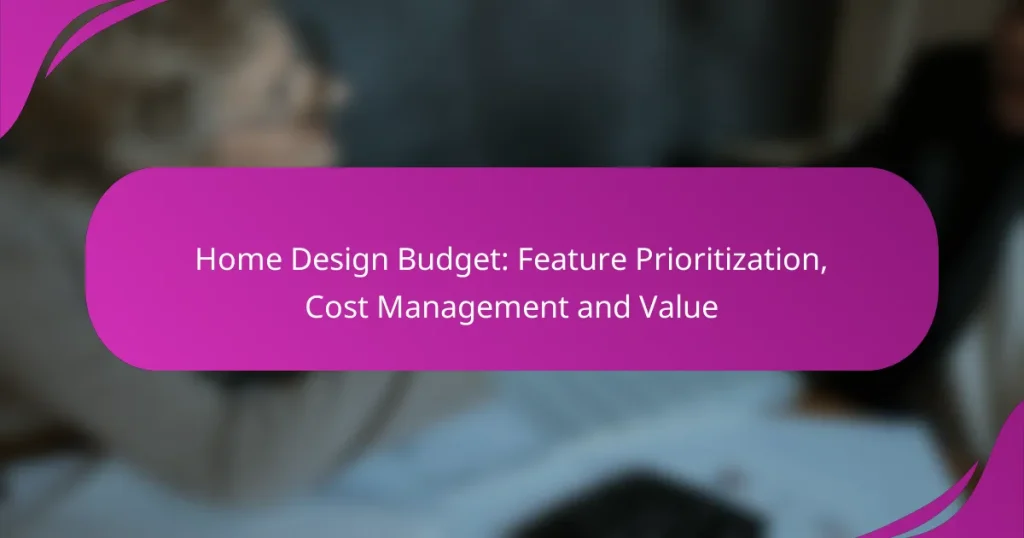When planning a home design budget in Canada, it’s crucial to prioritize features that not only enhance your living experience but also contribute to future resale value. Understanding the average costs associated with various renovations can help you allocate funds wisely, ensuring that your investments are both practical and beneficial. By implementing effective cost management strategies, you can achieve your design aspirations while staying within your budget.

How to prioritize features in home design budgets in Canada?
To effectively prioritize features in home design budgets in Canada, focus on essential elements that align with your lifestyle and future resale value. This approach helps ensure that your investments yield the best returns while meeting your immediate needs.
Identify essential features
Start by listing features that are crucial for your daily living. These may include a functional kitchen, adequate storage, and comfortable living spaces. Prioritize these essentials to ensure that your home meets your basic requirements.
Consider the layout and flow of spaces, as well as the quality of materials used. Investing in durable, high-quality essentials can save costs on repairs and replacements in the long run.
Assess lifestyle needs
Your lifestyle significantly influences which features should take precedence in your home design. For example, if you have a growing family, prioritize open spaces and multiple bedrooms. Alternatively, if you work from home, a dedicated office space may be essential.
Think about how you use your home daily and what features enhance your quality of life. This assessment can help you allocate your budget more effectively, ensuring that you invest in areas that truly matter to you.
Consider resale value
When prioritizing features, keep potential resale value in mind. Features like updated kitchens and bathrooms often yield higher returns on investment. Research local market trends to identify which features are most desirable in your area.
In Canada, energy-efficient upgrades and modern layouts are increasingly appealing to buyers. Balancing your personal preferences with market demands can lead to a more profitable investment.
Evaluate energy efficiency
Energy efficiency is a key consideration in home design that can impact both your budget and the environment. Features like high-efficiency windows, proper insulation, and energy-efficient appliances can reduce utility costs significantly.
Incorporating these elements may require a higher initial investment, but they often pay off through lower energy bills and increased home value. Look for products that meet Canadian energy standards to ensure compliance and efficiency.
Consult with design professionals
Engaging with design professionals can provide valuable insights into prioritizing features within your budget. Architects and interior designers can help you identify cost-effective solutions and innovative designs that align with your vision.
Consider getting multiple quotes and opinions to compare approaches and pricing. This collaboration can lead to a more refined design that maximizes your budget while fulfilling your needs and preferences.

What are the average costs of home design features in Canada?
The average costs of home design features in Canada can vary significantly based on the type of renovation and the materials used. Homeowners should expect to budget anywhere from low thousands to tens of thousands of Canadian dollars for various updates, depending on the scope of the project.
Kitchen remodel costs
Kitchen remodel costs in Canada typically range from CAD 15,000 to CAD 50,000, depending on the size and complexity of the project. Key factors influencing the cost include cabinetry, countertops, appliances, and flooring. For a mid-range remodel, consider allocating around CAD 25,000 to CAD 35,000.
To manage costs effectively, prioritize essential upgrades like energy-efficient appliances and durable countertops. Avoid overspending on luxury items that may not add significant value to your home.
Bathroom renovation expenses
Bathroom renovation expenses can vary from CAD 10,000 to CAD 30,000, with high-end projects potentially exceeding CAD 40,000. Factors such as fixtures, tile work, and plumbing significantly impact the overall budget. A standard bathroom remodel often falls within the CAD 15,000 to CAD 20,000 range.
Focus on maximizing space and functionality, especially in smaller bathrooms. Consider cost-effective updates like new fixtures and fresh paint to enhance the room without a complete overhaul.
Living room upgrades
Living room upgrades can cost between CAD 5,000 and CAD 20,000, depending on the extent of the changes. Common updates include new flooring, paint, and built-in shelving. A budget of CAD 10,000 is often sufficient for a moderate refresh.
When planning living room upgrades, think about the overall aesthetic and how each element works together. Avoid cluttering the space with too many decorative items, which can detract from the room’s appeal.
Outdoor space enhancements
Outdoor space enhancements typically range from CAD 5,000 to CAD 25,000, depending on the features you choose to incorporate. Popular options include decks, patios, and landscaping. For a basic outdoor upgrade, a budget of CAD 10,000 is a reasonable starting point.
Consider the climate and maintenance requirements when selecting materials for outdoor projects. Opt for durable, weather-resistant options to ensure longevity and reduce future costs.

How to manage costs effectively during home design?
Managing costs during home design involves careful planning, tracking, and prioritization. By setting a realistic budget, monitoring expenses, and focusing on key projects, you can keep your spending in check while achieving your design goals.
Set a realistic budget
Establishing a realistic budget is the foundation of effective cost management in home design. Consider all potential expenses, including materials, labor, permits, and unexpected costs, and aim for a budget that reflects your financial situation and design aspirations.
A good practice is to allocate around 10-20% of your budget for contingencies to cover unforeseen expenses. This helps prevent financial strain and ensures you can complete your project without compromising on quality.
Track expenses regularly
Regularly tracking expenses is crucial to stay within your budget. Use spreadsheets or budgeting apps to log every purchase, from large fixtures to small supplies, ensuring you have a clear overview of your spending.
Review your expenses weekly or bi-weekly to identify any areas where you may be overspending. This allows you to adjust your budget or make necessary changes before costs spiral out of control.
Prioritize DIY projects
Focusing on DIY projects can significantly reduce labor costs in home design. Identify tasks that you can handle yourself, such as painting, landscaping, or assembling furniture, which can save you money while adding a personal touch to your home.
However, be realistic about your skills and the time you can commit. For complex tasks, consider hiring professionals to avoid costly mistakes that could arise from inexperience.
Negotiate with contractors
Negotiating with contractors can lead to better pricing and terms for your home design project. Obtain multiple quotes and don’t hesitate to discuss your budget constraints with potential contractors to find a mutually agreeable solution.
Be clear about your expectations and ask for itemized estimates to understand where you can cut costs. Building a good rapport with contractors can also lead to better deals and flexibility in payment terms.

What financing options are available for home design projects in Canada?
In Canada, several financing options can help fund home design projects, including home equity loans, personal loans, credit card financing, and government grants. Each option has its own benefits and considerations, making it essential to evaluate them based on your financial situation and project needs.
Home equity loans
Home equity loans allow homeowners to borrow against the equity they have built in their property. Typically, lenders will offer loans up to 80% of the home’s appraised value minus any existing mortgage balance. This option often comes with lower interest rates compared to other forms of credit.
When considering a home equity loan, be mindful of the risks involved, such as the potential for foreclosure if you fail to repay. It’s advisable to shop around for the best rates and terms, as they can vary significantly between lenders.
Personal loans
Personal loans are unsecured loans that can be used for various purposes, including home design projects. These loans usually have fixed interest rates and repayment terms ranging from one to five years. The amount you can borrow typically depends on your credit score and income.
While personal loans can be a quick way to access funds, they may come with higher interest rates compared to secured loans. It’s crucial to assess your ability to repay the loan within the agreed timeframe to avoid financial strain.
Credit card financing
Using credit cards for financing home design projects can be convenient, especially if you have a card with a low interest rate or a promotional offer. This method allows for flexible spending, but it can lead to high-interest debt if not managed properly.
Consider using credit cards for smaller expenses or short-term projects, and aim to pay off the balance quickly to minimize interest costs. Be cautious of overspending, as it can quickly lead to financial challenges.
Government grants and incentives
In Canada, various government grants and incentives are available to support home improvement projects, particularly those focused on energy efficiency or accessibility. Programs may vary by province, so it’s essential to research local options that can help offset costs.
To take advantage of these programs, check eligibility requirements and application processes. Some grants may require specific documentation or project plans, so prepare in advance to ensure a smooth application experience.

What are the benefits of investing in high-value home design features?
Investing in high-value home design features can significantly enhance both the aesthetic appeal and functionality of your home. These features not only improve your living experience but can also lead to a higher resale value, making them a smart financial decision.
Increased property value
High-value home design features can substantially increase your property’s market value. Features such as modern kitchens, energy-efficient appliances, and well-designed outdoor spaces are particularly appealing to potential buyers and can lead to higher offers.
When considering which features to invest in, focus on those that yield the highest return on investment (ROI). For example, kitchen remodels typically recoup a significant portion of their costs, often ranging from 60% to 80% depending on the extent of the upgrades and local market trends.
To maximize property value, prioritize features that align with current buyer preferences in your area. Conducting market research or consulting with a local real estate agent can provide insights into which design elements are most sought after in your neighborhood.


